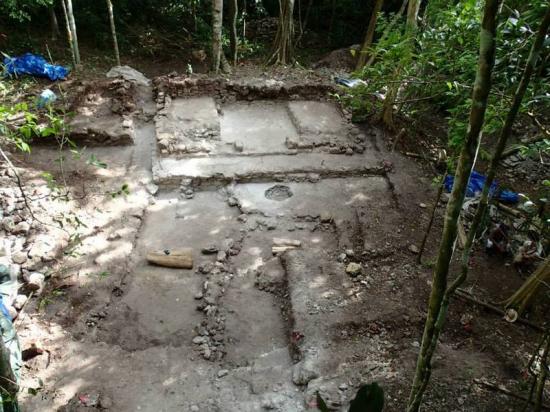Source - http://popular-archaeology.com/issue/03012014/article/archaeological-team-uncovers-elite-residential-complex
Researchers are now uncovering evidence that will shed light on the lifeways of Maya elites, the class of people who lived within that rung of society between the kings and royal households and the commoners of ancient Maya civilization.
For four weeks in July, 2013, a team of archaeologists, students and volunteers under the auspices of the Maya Research Program, based at the University of Texas in Tyler, excavated the remains of what is considered to be an elite residential complex or compound at the site of Xno'ha (named after the nearby Xno'ha Creek) in northwestern Belize. They discovered, in addition to architectural features, a cache of purposefully positioned Late Preclassic (400 BCE - 200 CE) ceramic vessels, and an Early Classic (200 - 600 CE) tomb.
Under the direction of site supervisor Alexander Parmington, excavators focused on a set of structures designated 'Patio Group 78'. A patio group, as defined by Maya archaeologists, is a complex of rectilinear structures placed on a levelled hill in an L-shape configuration that generally face eastward and are positioned around a central plaza or patio (open space). The Xno’ha Group 78 is described as a series of range structures, which are large, vaulted and multi-roomed. Patio groups are usually associated with individuals and families with elite status.
"The approach undertaken was to first locate the patio surface and baseline of two structures before broader stripping of the associated architecture," said Parmington. "Not only did the excavations reveal the final phases of the patio’s architecture, a large cache of nine Sierra Red vessels dating typologically to the Late Preclassic period (300 BCE - 250 CE) were recovered below the Patio’s exterior floor. Four of the vessels were staked in a lip-to-lip configuration with one vessel positioned immediately north and south of the stack. Phytolith analysis of the sediments contained within the vessels determined the presence of sponge spicules – indicating the vessel contained marine sponges."* The Pollen and phytolith analysis further indicated they contained large amounts of leaves from shrubs and trees, herbaceous monocots, palm fruits, and plant oils that may have been poured into a lower vessel.**
In addition to the cache, an Early Classic tomb was recovered, containing two marine shells and a tubular jade bead.*
Overall, Xno'ha is described as a medium-sized Maya center, composed of a large central plaza that is surrounded by numerous residential building groups. It was first identified in 1990 and then surveyed, mapped, and partially excavated between 2002 and 2004 before the current excavation series were initiated. Excavation results have thus far suggested that the site was occupied from the Late Preclassic to the Terminal Classic period (300 BCE – 925 CE).

Xno'ha shown within the context of other Maya centers in the region. (Courtesy Mark Wolf)

Overhead view of portion of excavated elite residential area at Xno'ha. Courtesy Maya Research Program.

Eye-level view of a portion of the exposed residential area. Courtesy Maya Research Program

The cache in situ, immediately after excavation. Courtesy Maya Research Program.

The cache restored to its appearance as originally configured. Courtesy Maya Research Program.
The site is being studied to help archaeologists gain a clearer picture of elite-elite and elite-commoner interraction, relationships, and Maya societal structure. Toward that end, researchers at Xno'ha Group 78 hope to build a ‘domestic structure database’ through the excavation of elite household groups and compounds within the site's settlement zone. "The establishment of such a database would provide a basis for a comparative study of behavior between royal elites and between royal elites and non-royal elites and commoners," says Parmington.**
It is not yet known how or if Xno'ha relates to the larger nearby Maya center of La Milpa. La Milpa is the largest Maya center closest to Xno'ha. It was likely the dominant regional power through the Late Preclassic period (300 BCE – 250 CE). Researchers hope future excavation and research will shed light on any such relationship.
More information about the programs of the Maya Research Program (MRP) can be found athttp://www.mayaresearchprogram.org/.
*Report Summary: Uncovering the Past at the Site of Xnoha, by Dr. Alexander Parmington.
** Report: Archaeological Field Report –Excavations Undertaken at Xnoha Building Group 78 by Maya Research Program 2013, by Alexander Parmington.